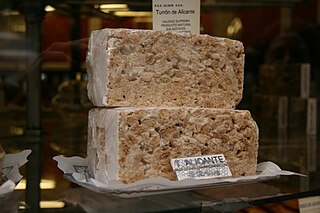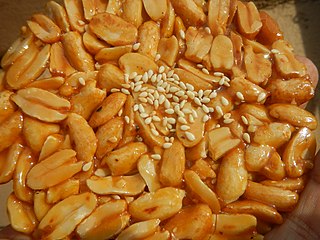
Porridge is a food made by heating or boiling ground, crushed or chopped starchy plants, typically grain, in milk or water. It is often cooked or served with added flavourings such as sugar, honey, fruit, or syrup to make a sweet cereal, or it can be mixed with spices, meat, or vegetables to make a savoury dish. It is usually served hot in a bowl, depending on its consistency. Oat porridge, or oatmeal, is one of the most common types of porridge. Gruel is a thinner version of porridge and congee is a savoury variation of porridge of Asian origin.

Breakfast cereal is a breakfast food made from processed cereal grains. It is traditionally eaten as part of breakfast, or a snack food, primarily in Western societies.

Glutinous rice is a type of rice grown mainly in Southeast and East Asia, and the northeastern regions of South Asia, which has opaque grains, very low amylose content, and is especially sticky when cooked. It is widely consumed across Asia.

Turrón, torró or torrone is a southwest European and Moroccan nougat confection, typically made of honey, sugar, and egg white, with toasted almonds or other nuts, and usually shaped either into a rectangular tablet or a round cake. Turrón is usually eaten as a dessert food around Christmas in Spain and Italy. It is also popular in Portugal, Morocco, and Latin America.

Puffed grains are grains that have been expanded ("puffed") through processing. They have been made for centuries with the simplest methods like popping popcorn. Modern puffed grains are often created using high temperature, pressure, or extrusion.

Filipino cuisine is composed of the cuisines of more than a hundred distinct ethnolinguistic groups found throughout the Philippine archipelago. A majority of mainstream Filipino dishes that compose Filipino cuisine are from the food traditions of various ethnolinguistic groups and tribes of the archipelago, including the Ilocano, Pangasinan, Kapampangan, Tagalog, Bicolano, Visayan, Chavacano, and Maranao ethnolinguistic groups. The dishes associated with these groups evolved over the centuries from a largely indigenous base shared with maritime Southeast Asia with varied influences from Chinese, Spanish, and American cuisines, in line with the major waves of influence that had enriched the cultures of the archipelago, and adapted using indigenous ingredients to meet local preferences.
Flattened rice is a type of rice dish made from raw, toasted, or parboiled rice grains pounded into flat flakes. They are eaten as is, toasted, fried, or used as ingredients or toppings for other dishes. Depending on their use, they can be crispy, crunchy, chewy, or soft in texture with a light nutty flavor. They are traditional to many rice-cultivating cultures in Southeast Asia and South Asia. It is also known variously as rice flakes, beaten rice, pounded rice, pressed rice or chipped rice.

Puffed rice and popped rice are types of puffed grain made from rice commonly eaten in the traditional cuisines of Southeast Asia, East Asia, and South Asia. It has also been produced commercially in the West since 1904 and is popular in breakfast cereals and other snack foods.
Mithai (sweets) are the confectionery and desserts of the Indian subcontinent. Thousands of dedicated shops in India, Bangladesh, Nepal, Pakistan and Sri Lanka sell nothing but sweets.

A rice cake may be any kind of food item made from rice that has been shaped, condensed, or otherwise combined into a single object. A wide variety of rice cakes exist in many different cultures in which rice is eaten. Common variations include cakes made with rice flour, those made from ground rice, and those made from whole grains of rice compressed together or combined with some other binding substance.

Tapai is a traditional fermented preparation of rice or other starchy foods, and is found throughout much of Southeast Asia, especially in Austronesian cultures, and parts of East Asia. It refers to both the alcoholic paste and the alcoholic beverage derived from it. It has a sweet or sour taste and can be eaten as is, as ingredients for traditional recipes, or fermented further to make rice wine. Tapai is traditionally made with white rice or glutinous rice, but can also be made from a variety of carbohydrate sources, including cassava and potatoes. Fermentation is performed by a variety of moulds including Aspergillus oryzae, Rhizopus oryzae, Amylomyces rouxii or Mucor species, and yeasts including Saccharomyces cerevisiae, and Saccharomycopsis fibuliger, Endomycopsis burtonii and others, along with bacteria.

Pinipig is a flattened rice ingredient from the Philippines. It is made of immature grains of glutinous rice pounded until flat before being toasted. It is commonly used as toppings for various desserts in Filipino cuisine, but can also be eaten plain, made into cakes, or mixed with drinks and other dishes.

Lumpia are various types of spring rolls from Indonesia and the Philippines. Lumpia are made of thin paper-like or crepe-like pastry skin called "lumpia wrapper" enveloping savory or sweet fillings. It is often served as an appetizer or snack, and might be served deep-fried or fresh (unfried). Lumpia are Indonesian and Filipino adaptations of the Fujianese rùnbǐng and Teochew popiah, usually consumed during Qingming Festival.

Cornick is a Filipino deep-fried crunchy puffed corn nut snack. It is most commonly garlic-flavored but can also come in a variety of other flavors. It is traditionally made with glutinous corn.

Panocha mani, or simply panutsa or samani, is a Filipino brittle confection made with muscovado sugar or sangkaka, whole peanuts, and butter. It can also be made with whole pili nuts. It is similar to bagkat, another Filipino confection made from ground roasted or fried nuts and sugar, but the latter has a chewy texture. It is also sometimes called piñato mani, piñato de Cebu, or simply piñato in the Visayas Islands.














